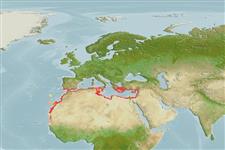Lớp phụ Cá sụn (cá mập và cá đuối) (sharks and rays) >
Myliobatiformes (Stingrays) >
Rhinopteridae (Cownose rays)
Etymology: Rhinoptera: Greek, rhinos = nose + Greek,pteron = fin, wing (Ref. 45335).
Issue
Considered valid in McEachran and Seret 1990 (Ref. 4441) but with a note that more recent authors consider it to be immature stages of R. marginata. Further study is needed to clarify problem (Ref. 4441). Tentatively valid in Last et al., 2016, for these differ subltly in their morphology (Ref. 114953:719).
Environment: milieu / climate zone / depth range / distribution range
Sinh thái học
Biển Sống nổi và đáy. Subtropical; 38°N - 15°N, 18°W - 36°E
Eastern Atlantic: southern Spain to Senegal, including the Mediterranean.
Bộ gần gũi / Khối lượng (Trọng lượng) / Age
Maturity: Lm ? range ? - ? cm
Max length : 200 cm WD con đực/không giới tính; (Ref. 6678)
Found in tropical to warm temperate coastal waters, but absent from islands of western Pacific. Often forming large groups swimming near the surface and quite destructive of commercial oyster and clam beds. Feeds on bottom-living mollusks, crustaceans and fishes. Seldom marketed. Ovoviviparous, gestation period up to one year with 2-6 embryos produced.
Life cycle and mating behavior
Maturities | Sự tái sinh sản | Spawnings | Egg(s) | Fecundities | Ấu trùng
Exhibit ovoviparity (aplacental viviparity), with embryos feeding initially on yolk, then receiving additional nourishment from the mother by indirect absorption of uterine fluid enriched with mucus, fat or protein through specialised structures (Ref. 50449).
McEachran, J.D. and B. Séret, 1990. Rhinopteridae. p. 71-72. In J.C. Quero, J.C. Hureau, C. Karrer, A. Post and L. Saldanha (eds.) Check-list of the fishes of the eastern tropical Atlantic (CLOFETA). JNICT, Lisbon; SEI, Paris; and UNESCO, Paris. Vol. 1. (Ref. 4441)
IUCN Red List Status (Ref. 130435)
Threat to humans
Harmless
Human uses
Các nghề cá: Tính thương mại
Các công cụ
Special reports
Download XML
Các nguồn internet
Estimates based on models
Preferred temperature (Ref.
123201): 17.1 - 21.7, mean 19.7 °C (based on 136 cells).
Phylogenetic diversity index (Ref.
82804): PD
50 = 0.5039 [Uniqueness, from 0.5 = low to 2.0 = high].
Bayesian length-weight: a=0.01148 (0.00463 - 0.02844), b=2.98 (2.76 - 3.20), in cm total length, based on LWR estimates for this (Sub)family-body shape (Ref.
93245).
Mức dinh dưỡng (Ref.
69278): 3.8 ±0.60 se; based on food items.
Thích nghi nhanh (Ref.
120179): Rất thấp, thời gian nhân đôi của chủng quần tối thiểu là hơn 14 năm (Fec=2).
Fishing Vulnerability (Ref.
59153): Very high vulnerability (85 of 100).
Nutrients (Ref.
124155): Calcium = 11 [2, 53] mg/100g; Iron = 0.54 [0.13, 1.54] mg/100g; Protein = 21.5 [16.4, 26.6] %; Omega3 = 0.193 [0.054, 0.609] g/100g; Selenium = 23.5 [7.3, 75.5] μg/100g; VitaminA = 8.83 [2.81, 27.94] μg/100g; Zinc = 0.539 [0.260, 0.995] mg/100g (wet weight);
